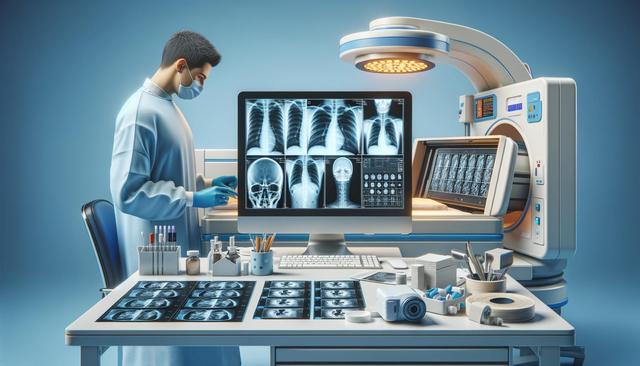The Role of X-ray Technicians in Diagnostic Imaging
X-ray technicians play a vital role in the medical field by supporting diagnostic imaging services that aid in the detection and management of various health conditions. Often working in hospitals, outpatient care centers, and other healthcare settings, these professionals are trained to operate imaging equipment safely and effectively. Their responsibilities include preparing patients for procedures, ensuring accurate imaging results, and collaborating with physicians to deliver optimal care. As medical imaging continues to evolve, so does the need for well-trained X-ray technicians who can adapt to new technologies and methods. For those interested in joining the profession, pursuing a Radiology Online Degree provides a flexible and accessible pathway to gain the necessary knowledge and credentials.
Training and Education for Aspiring X-ray Technicians
Becoming an X-ray technician typically requires formal education and clinical training. Many individuals begin by enrolling in accredited programs that offer specialized instruction in radiologic technology. These programs are available at community colleges, vocational schools, and increasingly through online platforms. Radiology Online Courses are particularly advantageous for students who need to balance their studies with work or family responsibilities. These courses cover essential topics such as anatomy, patient care, radiation safety, and imaging techniques. Students also participate in hands-on training through clinical placements at affiliated healthcare facilities, which is crucial for gaining practical experience.
Key components of X-ray technician training include:
- Understanding radiographic procedures and protocols
- Learning to use and maintain imaging equipment
- Developing communication skills for patient interaction
- Mastering safety measures for radiation protection
Graduates of these programs are typically eligible to sit for certification exams, which may be required by employers or regulatory bodies depending on the region.
Work Environments and Daily Responsibilities
X-ray technicians are employed in a variety of healthcare settings, each offering different experiences and challenges. These include:
- Hospitals and emergency departments
- Outpatient diagnostic imaging centers
- Specialty clinics such as orthopedics and oncology
- Nursing homes and long-term care facilities
Their daily responsibilities involve operating imaging machines, positioning patients correctly, and ensuring that high-quality images are captured for diagnostic interpretation. In addition to technical skills, X-ray technicians must possess strong interpersonal abilities to support patients who may be anxious or in pain. Proper documentation, adherence to protocols, and collaboration with radiologists and other healthcare professionals are all part of the routine. For those looking to advance their careers, earning an Online Radiology Degree can open doors to roles such as MRI technologist or radiologic technologist supervisor.
Technological Advancements in Radiologic Imaging
The field of radiologic imaging is constantly changing due to rapid advancements in technology. X-ray technicians must stay updated with the latest innovations to remain effective in their roles. Digital radiography, for instance, has largely replaced traditional film-based methods, offering quicker image processing and reduced radiation exposure. Other emerging technologies include 3D imaging systems, portable X-ray units, and artificial intelligence tools that assist in diagnostics. As new equipment becomes standard in many practices, ongoing professional development is essential.
Some ways technicians can stay current include:
- Attending professional workshops and conferences
- Participating in continuing education programs
- Completing advanced certifications in specialized imaging modalities
- Enrolling in Radiology Online Courses tailored to new technologies
This commitment to learning not only enhances job performance but also improves patient outcomes by ensuring accurate and timely diagnoses.
Career Outlook and Professional Development
The demand for X-ray technicians is expected to grow steadily as the population ages and the need for diagnostic imaging increases. According to various labor statistics, employment opportunities in radiologic technology are projected to rise in the coming years. This trend is driven by a growing emphasis on non-invasive diagnostic tools and the expansion of healthcare services into rural and underserved areas. Professionals who pursue additional training or certifications often find greater job stability and advancement potential.
For those considering a long-term career in medical imaging, further education is a valuable investment. A Radiology Online Degree can provide a foundation for roles in education, administration, or specialized imaging fields. Professional organizations also offer resources for networking, certification renewal, and career guidance. Whether just starting out or looking to progress, the radiologic field offers a variety of pathways for growth and fulfillment.
Conclusion: Opportunities in Radiologic Technology
For individuals interested in healthcare, technology, and patient interaction, a career as an X-ray technician offers a meaningful and rewarding path. With the support of educational options such as Radiology Online Degree programs and Radiology Online Courses, entering this field has become more accessible than ever. As imaging equipment and healthcare services continue to evolve, X-ray technicians will remain essential contributors to patient care across a wide range of settings. Whether working in hospitals, clinics, or specialized imaging centers, these professionals help ensure accurate diagnoses and contribute to effective treatment planning. By staying current with advances and continuing their education, X-ray technicians can build a stable and impactful career in diagnostic imaging.




Leave a Reply